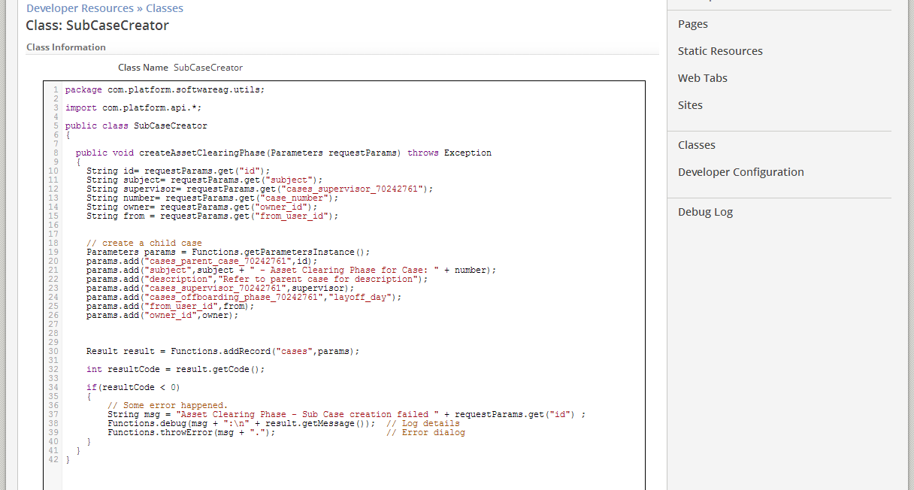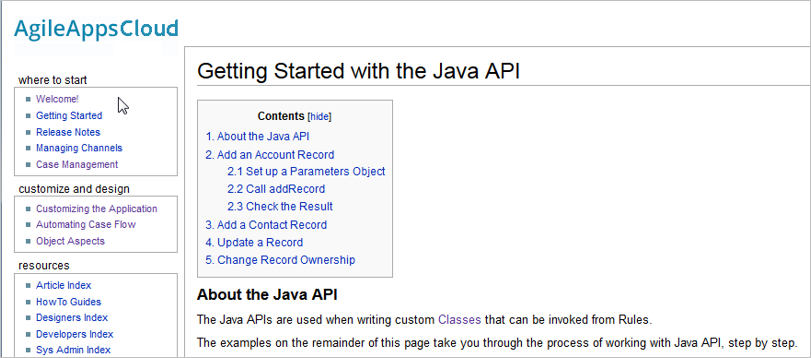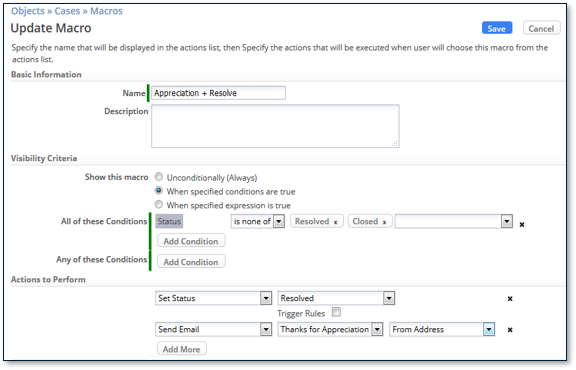Exercise 08: Integrating a Web Service and a Java API Class
From AgileApps Support Wiki
Introduction
Adding Integration Logic
Accessing Web Pages using Web Tabs
- A Web Tab displays a local JSP page, or an (external) page specified by a URL
- Examples:
- Company's intranet site from another server
- Partner website from another server
- Support website from another server
- Custom Page created on the tenant
Adding Web Tabs
- Web Tabs appears in an application only for the Application Roles you specified
- Optional: Passing parameters to external web page you are invoking
Integrating Web Services into your Application
- Web Services get data from an external source
- You can use Web Services:
- In External Lookup fields
- To retrieve “related records” from an External Data Source
- In process steps of type “Execute Web Service”
- You can also create a two-step “pipeline service”
- For example: Handle authorization in the first step and get data in the second step
- Once you define a Web Service, it is available to every application on your tenant
Defining a Web Service
- Create a new Developer Resource of kind Web Service
- Select which type:
- SOAP:
- Upload a WSDL file that describes the remote service (Many operations can be defined in a single WSDL file)
- Select the operation you want to call and the version
- REST:
- Provide sample input and output data (XML or JSON)
- The platform extracts the parameter names, as if they were declared in a WSDL
- SOAP:
- Specify parameters to ignore and supply hard-coded values
- Remaining parameters are mapped when the Web Service is invoked
Using a Web Service in an External Lookup Field
- External Lookup field retrieves one or more records from a Web Service
- Invoked when an object record is added or updated
- External Lookup can invoke:
- A Web Service as lookup service that returns a single record
- A Web Service as search service that returns multiple records, the user selects from a popup which record to use
- To configure a lookup service
- Select configured Web Service
- Perform Input Mapping: Map values, record fields, user input, or expressions to become Web Service input(s)
- Perform Output Mapping Map or ignore Web Service output(s) to read-only fields that can be placed at the desired location in the record form
Using a Web Service to Access an External Data Source
- An External Data Source lets you access a collection of related records from an external data store
- Records can be displayed in the Related Information section on an object form
- A Web Service must be configured to supply the records
- To configure an External Data Source:
- Select configured Web Service
- Perform input and output mapping of Web Service parameters
- Specify record structure of expected related records
Using a Web Service in Execute Web Service Process Step
- Process Step of type Execute Web Service allows to invoke a configured Web Service in a Process Model
- Process Model Editor allows to map Web Service inputs and outputs to parameters used in the Process Model
- A Web Service output can be mapped to a Process Variable
- Can be used as input to another Web Service, or as criteria for a Decision Switch
- To create a Process Variable select “Use Variable” in the Output Mapping section of a Web Service step and give it a name
- Process Variables and Persistence:
- Process variables do not persist beyond the life of the process
- Store the value in a record field when:
- Persistence is needed (a record is always available for that purpose!)
- The value is needed in a Callable Process
- For a Callable Process, data is also passed in a record field
Execute Web Service Process
- Execute Web Service
- Invokes one of the Web Services configured for the application
- Input Mapping: Map Object fields of the current record, fixed values or expressions to the WS inputs
- Output Mapping: Map Web Service results or expressions to Object fields of the current record or Process Variables
- Execute Web Service
Integrating a Web Service (Hands on Lab Part 1)
Extend and Integrate with Custom Java Code
Using Classes in Business Rules
- To invoke a method defined in a custom Java Class from a Business Rule:
- Select Invoke Method in the Actions to Perform section
- To invoke a method defined in a custom Java Class from a Business Rule:
Writing For details on how to write code for the Java APIs, see the webMethods AgileApps Cloud documentation
- Select the Configuration > Learn More link and do a search for JAVA API
- Dozens of Java APIs are available for use in a Java class
- Custom Java Classes and Using the Java API
- Select the Configuration > Learn More link and do a search for JAVA API
Macros
- Lets you do several things at once
- Object-related, appear in sidebar in Actions dropdown (like Custom Form Action)
- Visibility criteria:
- Determines who sees it the Action list
- Use field conditions or expressions
- Tip: When creating expressions, use the field comparisons to find values:*
- Actions to perform:
- Set field values, add a note, assign to User/Team, send email, start/stop Process, change Process status, execute Business Rules, execute a Web Service*, invoke Java method*
Exercise
This exercise has two parts:





